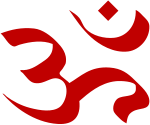
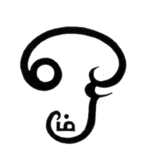
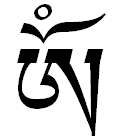

India is a land of innumerable beliefs, rituals and religious symbols. These beliefs and symbols are highly respected and revered.
The origin of the syllable OM is lost in the misty past. Its not being specific to any one country or civilization is indicative of its being an universally perceptible sound for the human race. This reason for this universal perceptibility possibly lies in the fact that AAAH is the most natural sound that issues from the human larynx. This is evident when a man cries out naturally in extreme pain, anger or fear. When emotions reach an extreme pitch the articulate sounds evolved by man are not the ones that are heard, but the syllable natural to man which is AAAH.
As a devout people we normally do not go into the meaning and interpretation of our many beliefs. It is sufficient for most of us to know that they are part of the heritage handed down to us by our ancestors and in deference to tradition it becomes our duty to scrupulously and meticulously adhere to them. But by doing things without knowing the meaning behind them do we not deprive ourselves of an insight into our heritage?
Culture can be well appreciated and adapted to changing times if the meaning behind its different constituents is well understood. To develop this understanding one has to look upon all human actions as having originated in human society. While answers to all questions cannot be obtained, the acceptance of this approach at least opens the door to inquiry into the circumstances which gave rise to our revered traditions.
An attempt to interpret our religious beliefs and symbols is a challenging task. Many of these issues defy analysis and call for a judicious combination of the study of the social environment, etymology, aesthetics and philosophy. As far as aesthetics and philosophy go there exists a good deal of subjectivism and value judgement. While talking about etymology and the social environment we are on relatively firmer ground. In this chapter we have taken a set of symbols, beliefs and rituals and have attempted to examine the possible meaning behind them and the reasons which could lie behind their origin. The first religious symbol we take up is that of Om or Omkar.
OM or Omkar
The syllable OM is quite familiar to a Hindu. It occurs in every prayer. Invocation to most gods begin with this syllable. For instance we have Om Namaha Shivaya, Hari Om, Om Shanti etc. OM is also pronounced as AUM.
Is OM present in Christianity as 'Amen' and in Islam as 'Amin'?
This term occurs in various ancient and modern civilizations. It exists Hinduism, Christianity and Islam.
In Arabic the first alphabet is pronounced as aliph. In Greek it is alpha, in the Roman script it is A. Thus in many languages the first letter in the alphabet has the syllable A, with which the word AUM or OM begins. In the Greek alphabet the last letter is Omega which comes very close to OM. Thus the significance of the syllable OM as the beginning and end finds a parallel in many of the scripts associated with ancient languages.
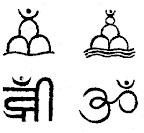 |
The different ways in which Omkar is depicted. The syllable OM is not specific to Indian culture. It has religious significance in other religions also. The word Amen used among Christians at the end of a prayer is also said to be derived from the the syllable OM. Although OM is not given any specific definition and is considered to be a cosmic sound, a primordial sound, the totality of all sounds etc., Amen is said to mean 'May it be so'.
In Arabic a similar term 'Amin' has a religious significance
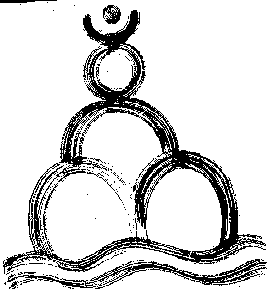 | |
This indicates some link between the various symbols and perhaps a common origin. Even in the English language the syllable �m occurs in words having a similar meaning. for instance; Omniscience means infinite knowledge, Omnipotent means having infinite powers Omnivorous means eating or reading every thing. This syllable also occurs in words such as Omen which means a sign of something that is to occur in future, Ombudsman means a person having authority to pronounce a verdict. Thus Om is also used to signify divinity and authority.
The syllable OM is not specific to Indian culture. It has religious significance in other religions also. The word Amen used among Christians at the end of a prayer is also said to be derived from the the syllable OM. Although OM is not given any specific definition and is considered to be a cosmic sound, a primordial sound, the totality of all sounds etc., Amen is said to mean 'May it be so'.
In Arabic a similar term 'Amin' has a religious significance.
This is believed to be the original depiction of the syllable OM. We can see how similar it is to the Englisg (Latin) letter 'M' as also to the greek letter 'Omega'.
Thus the origin of the syllable OM is lost in the misty past. Its not being specific to any one country or civilization is indicative of its being an universally perceptible sound for the human race. This reason for this universal perceptibility possibly lies in the fact that AAAH is the most natural sound that issues from the human larynx. This is evident when a man cries out naturally in extreme pain, anger or fear. When emotions reach an extreme pitch the articulate sounds evolved by man are not the ones that are heard, but the syllable natural to man which is AAAH.
This sound it can be said would have been associated with man, in absence of articulate speech, as are the various sounds of barking, meowing, bellowing that we associate with different animals. This perhaps is the reason why the syllable beginning with the letter 'A' is the first one in most alphabets. And this perhaps is also the reason for the Deification of the syllable AUM or OM






4 comments:
Here you can find Hindu God Goddess Photo of Shiva, Laxmi Picture, Indain Rama Wallpapers, Sai Baba, Ganesha, Kartike, Krishna Picture, Goddess Parvati, Goddess Sarswati Wallpapers, Sri Ganesh Snaps, Vishnu, Brahma Snaps, Indain Sri Shirdiwale Sai Baba, Shri Hanumanji, Shri Ramji, Vishnuji, Brahmaji, Kartikeya, Buddha, Tirupati Balaji, Shrinathji Hindu God Goddess Photo of Shiva, Laxmi Picture, Indain Rama Wallpapers, Sai Baba, Ganesha, Kartike, Krishna Picture, Goddess Parvati
I have designed few Wallpapers based on Hindu Symbol OM.
If you like to check it out visit - http://maulikdave.blogspot.com/search/label/wallpaper
The OM syllable is "not being specific to any one country or civilization". Try digging into Dacian history and civilization, the people that even the ancient greeks believed to be sacred. OM represent Zamolxis, the Man-God. You should read a little bit more before making such unfounded suppositions.
What a nice blog site it is! unbelievable.When I have read this blog I can understand every things I can also learn clearly about Hindu God Brahma.This blog's photos are very nice and bearing the history of religion.So I thing this sites aggregated of all very very reliable like a site .
We also apply Hindu symbols on the body of our colored glass Glass.
Please watch our -- hindu symbols
Post a Comment